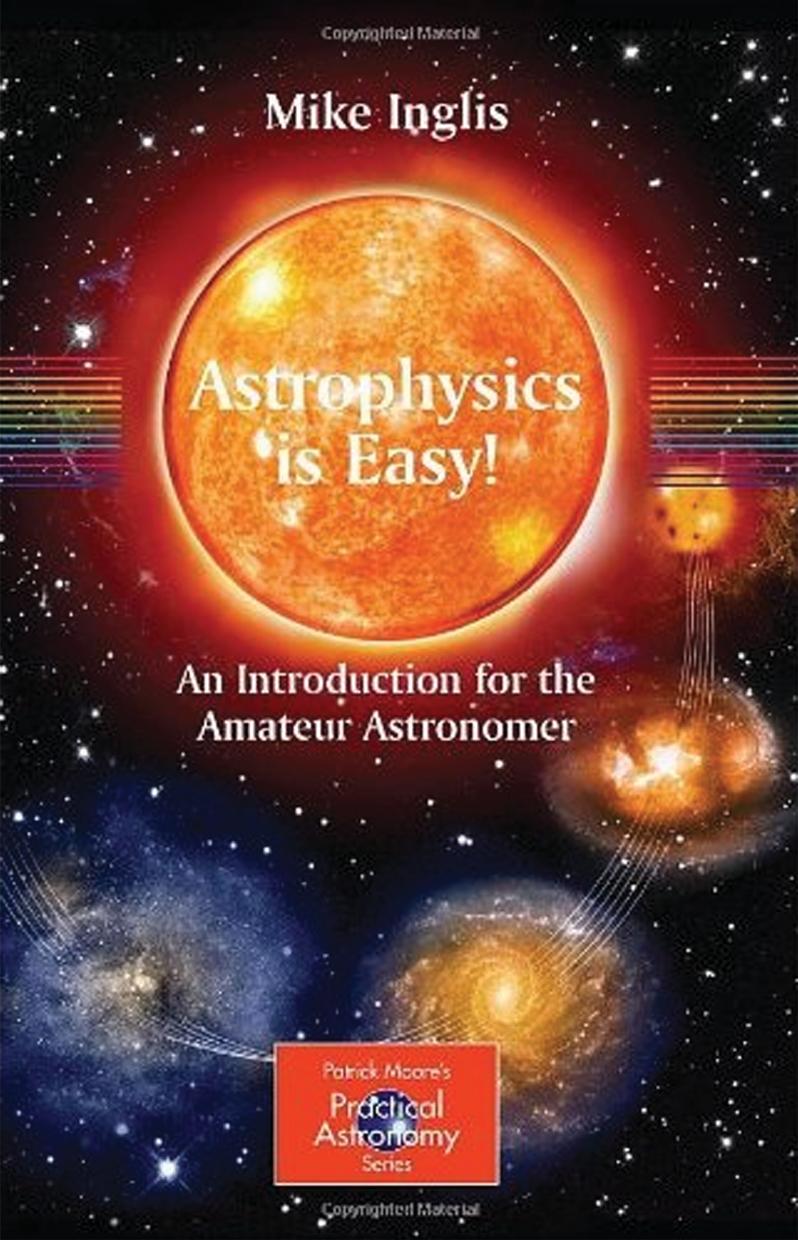Astrophysics is Easy!: An Introduction for the Amateur Astronomer by Mike Inglis

Author:Mike Inglis
Language: eng
Format: epub, pdf
Tags: Springer, ISBN-13: 9781852338909
Stars
101
So, a Sirius will burn hydrogen in its core for about 1/6 54 × 1010 years, or about
1.5 billion years.
On the other hand, a main-sequence star with a mass of 0 5 M will have a lifetime
of:
1
=
1√ = 1 = 5 66solar lifetimes
0 52 5
0 52 0 5
0 177
which is about 56 billion years.
3.9 Red Giant Stars
Although the amount of hydrogen in a star’s core is vast, it is not infinite, and
so, after a very long time, the production of energy will cease when the central
supply of hydrogen is used up. Throughout the length of time that nuclear fusion
has been taking place, the hydrogen has been transformed into helium, by way
of the proton-proton chain, and without this source of energy, the star uses
gravitational contraction to supply its energy needs. Thus, the core will start to
cool down, which means that the pressure also decreases, with the result that the
outer layers of the star begin to weigh down on the core and compress it. This
has the effect of causing the temperature within the core to rise again, and for
heat to flow outward from the core. Note that although a tremendous amount of
heat is formed now, it is not due to nuclear reactions but to gravitational energy
being converted into thermal energy.
In a relatively short time, astronomically speaking, the region around the
star’s hydrogen-depleted core will become hot enough to begin nuclear fusion of
hydrogen into helium, in a thin shell around the core, in a process called shell
hydrogen-burning. This is shown in Figure 3.12.
The core will consist of helium, but the outer layers are hydrogen rich. The
shell, where energy production occurs, is relatively thin. [Note: figure to scale.]
For a star like the Sun, this hydrogen-consuming shell develops almost immedi-
ately from the moment nuclear fusion stops in the core, and so the supply of
energy is more or less constant. For massive stars, there can be an interval of
perhaps a few thousand years to a few million years from the end of the core
nuclear-fusion phase to the beginning of the shell hydrogen-burning phase.
The new supply of energy, and thus heat, has the effect of causing the rate
of shell hydrogen-burning to increase, and so it begins to eat further into the
surrounding hydrogen. The helium that is the by-product of the hydrogen fusion
in the shell falls to the center of the star, where, along with the helium already
there, it heats up as the core continues to contract and increase its mass. In the
case of, say, a 1 M star, the core will be compressed to as much as one-third
of its original size. The result of this core compression is an increase in the
temperature, from about 15 million K to nearly 100 million K.
Now, most of what has happened in this stage of a star’s life has occurred
inside of it and so was invisible to our eyes. Nevertheless, it does have effects
Download
Astrophysics is Easy!: An Introduction for the Amateur Astronomer by Mike Inglis.pdf
This site does not store any files on its server. We only index and link to content provided by other sites. Please contact the content providers to delete copyright contents if any and email us, we'll remove relevant links or contents immediately.
Tools of Titans by Timothy Ferriss(7817)
Turbulence by E. J. Noyes(7704)
Astrophysics for People in a Hurry by Neil DeGrasse Tyson(5003)
Secrets of Antigravity Propulsion: Tesla, UFOs, and Classified Aerospace Technology by Ph.D. Paul A. Laviolette(4997)
Design of Trajectory Optimization Approach for Space Maneuver Vehicle Skip Entry Problems by Runqi Chai & Al Savvaris & Antonios Tsourdos & Senchun Chai(4845)
Room 212 by Kate Stewart(4740)
Pale Blue Dot by Carl Sagan(4620)
The David Icke Guide to the Global Conspiracy (and how to end it) by David Icke(4384)
A Journey Through Divination and Astronomy by Publishing Pottermore(4251)
Apollo 8 by Jeffrey Kluger(3514)
Goodbye Paradise(3452)
Losing the Nobel Prize by Brian Keating(3426)
COSMOS by Carl Sagan(3352)
The Five People You Meet in Heaven by Mitch Albom(3336)
Brief Answers to the Big Questions by Stephen Hawking(3242)
How to Read Water: Clues and Patterns from Puddles to the Sea (Natural Navigation) by Tristan Gooley(3241)
How to Read Nature by Tristan Gooley(3080)
The Order of Time by Carlo Rovelli(3075)
A Brief History of Time by Stephen Hawking(2820)
